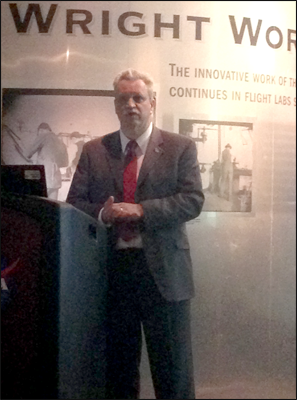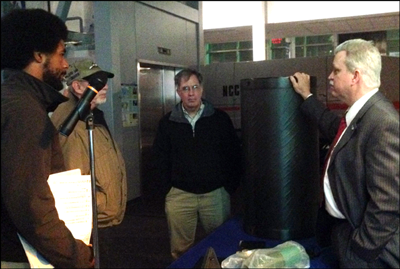 |
|
 On Tuesday, January 13th, Dr. Linda Hayden, PI of the Center of Excellence in Remote Sensing Education and Research (CERSER) led several representatives from Elizabeth City State University to the NASA Langley Sigma Series, a Forum on Science and Technology. This event was held at the Virginia Air & Space Center's Pearl Young Theater and featured Mr. Brian K. Stewart a Senior Researcher in NASA Langley's Research Directorate. The title of his presentation was: Taking the Long View: How ISAAC Prepares LaRC for the Future. On Tuesday, January 13th, Dr. Linda Hayden, PI of the Center of Excellence in Remote Sensing Education and Research (CERSER) led several representatives from Elizabeth City State University to the NASA Langley Sigma Series, a Forum on Science and Technology. This event was held at the Virginia Air & Space Center's Pearl Young Theater and featured Mr. Brian K. Stewart a Senior Researcher in NASA Langley's Research Directorate. The title of his presentation was: Taking the Long View: How ISAAC Prepares LaRC for the Future.
Those attending with Dr. Hayden included: Dr. Cheryl Lewis, Andrew Brumfield, and Hagan Hodgkins. |
| |
 Brian Stewart Brian Stewart
Brian Stewart is a Senior Researcher in NASA Langley's Research Directorate. He has 35 years of experience with the research, engineering, development, and activation of numerous systems for NASA, industry and the US Navy. For the last two years, he has worked with a highly motivated team to advocate for, acquire and stand up ISAAC as a robust NASA capability. His expertise includes design and engineering of hypersonic facilities, robotic positioning systems, liquid-vapor cooling of solid-state lasers, soft composites research, hypervelocity test articles, shipboard systems and project management. He holds a BS in Mechanical Engineering from Old Dominion University, and an MS in Mechanical Engineering from Georgia Tech. |
| |
Abstract
 In 2012, a small team of NASA Langley engineers formulated a strategy to expand a new commercial robotic composites fabrication platform into a robust research capability to advance the state-of-the-art of composite structures, materials and processing. Instead of focusing on the machine's single purpose, the team instead formulated a bold, broad concept; with the accuratized, flexible robotic platform linking previously existing Langley Research Center expertise and capabilities. This expanded vision, the Integrated Structural Assembly of Advanced Composites In 2012, a small team of NASA Langley engineers formulated a strategy to expand a new commercial robotic composites fabrication platform into a robust research capability to advance the state-of-the-art of composite structures, materials and processing. Instead of focusing on the machine's single purpose, the team instead formulated a bold, broad concept; with the accuratized, flexible robotic platform linking previously existing Langley Research Center expertise and capabilities. This expanded vision, the Integrated Structural Assembly of Advanced Composites  (ISAAC), positions Langley to fulfill our key role in aerospace structures well into the future. While many see ISAAC only as a robot, the robotic mobility platform is but a single element of the broader concept. The integrated ISAAC capability includes engineering, analysis, design, tooling, layup, cure, inspection, testing and test data correlation. The lecture will include updates on the current state of the system, the integration of numerous activities across the Center and Agency, and an unexpected and surprising example that highlights the value of "Taking the Long View." (ISAAC), positions Langley to fulfill our key role in aerospace structures well into the future. While many see ISAAC only as a robot, the robotic mobility platform is but a single element of the broader concept. The integrated ISAAC capability includes engineering, analysis, design, tooling, layup, cure, inspection, testing and test data correlation. The lecture will include updates on the current state of the system, the integration of numerous activities across the Center and Agency, and an unexpected and surprising example that highlights the value of "Taking the Long View." |
| |
  |
| |
|
 |
 |
|
